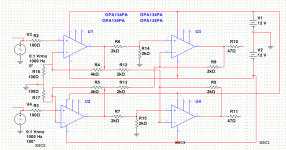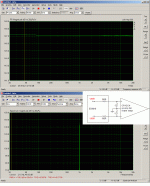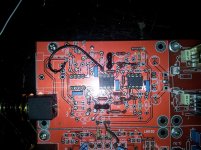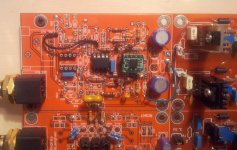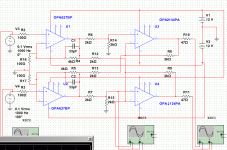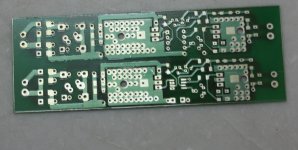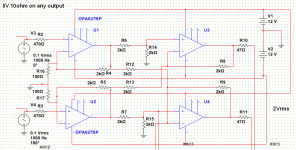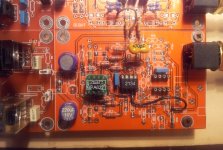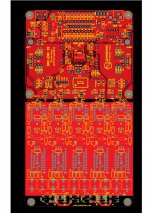Here the new measurement with low I/V resistances, the LL1684 with a turn ratio 1:1 is not bad
nice information
thanks!
FYI I didn't measure. It just sounded right.
OK, I seen it, thank you very much!
Hello !
Speaking about left D schematic (resistors on primary):
Did you test also, but without grounding CT on primary ?
I didn't have measured, but to "my ears", it sound better with only one resistor (6 ohms) across primary, and x50 tube stage.
Thanks
Richard
My impression too. Not a great difference but definitely better. Maybe the transformer dislikes any small dc imbalance...
Hello Analog-sa
I happy you confirm what I feel, but without real measures, I will always have a doubt ...
I happy you confirm what I feel, but without real measures, I will always have a doubt ...
Here the last opamp output stage and the relative measurements.
Some capacitors will be add in the future to create a low order filter for high frequency.
P.S. The GND on this module must be the real DAC analog gnd not the Voffest.
Some capacitors will be add in the future to create a low order filter for high frequency.
P.S. The GND on this module must be the real DAC analog gnd not the Voffest.
Attachments
I'm following the Dac End R dear quanghao 🙂 i'm in a dilemma with Dac End 2...
Thank,
New op-amp output stage.
33pF compensation on first stage
103=0.01uF ceramic compensation on negative shunt
reduced voltage to 12V on outptu stage
OP627 on first stage (with dual chip dip adapter) and OPA2134 on second stage.
now there only a little noise on headphone probably it is possible to eliminate it reducing the voltage gain on first stage and setting I/V resistor to 10ohm instead of 5ohm, I will try soon.
33pF compensation on first stage
103=0.01uF ceramic compensation on negative shunt
reduced voltage to 12V on outptu stage
OP627 on first stage (with dual chip dip adapter) and OPA2134 on second stage.
now there only a little noise on headphone probably it is possible to eliminate it reducing the voltage gain on first stage and setting I/V resistor to 10ohm instead of 5ohm, I will try soon.
Attachments
OSCILLATOR
---------------------------
Actually I am using a 49.xx MHz oscillator and in the future will test 100MHz
I have read this about 125 MHz
http://www.diyaudio.com/forums/digital-line-level/147817-ackodac-based-es9018-48.html
XG-1000CA 125.00MHZ 50PPM CB - EPSON TOYOCOM - OSC., SEGA, 125,00MHZ, 50PPM, | Farnell Italia
Oscillatori XO SMD 3.3V 125.00MHz 5x7mm EPSON TOYOCOM XG-1000CA 125.00MHz 50ppm CB consegna in 24 ore
RS will have this component in december.
---------------------------
Actually I am using a 49.xx MHz oscillator and in the future will test 100MHz
I have read this about 125 MHz
http://www.diyaudio.com/forums/digital-line-level/147817-ackodac-based-es9018-48.html
XG-1000CA 125.00MHZ 50PPM CB - EPSON TOYOCOM - OSC., SEGA, 125,00MHZ, 50PPM, | Farnell Italia
Oscillatori XO SMD 3.3V 125.00MHz 5x7mm EPSON TOYOCOM XG-1000CA 125.00MHz 50ppm CB consegna in 24 ore
RS will have this component in december.
I do not think it is a wise idea to use this clock, in his reply Joe did not even seem to have considered the possibility that it may brown out the dac chip when we mentioned it, this is far above the recommended max speed clock for ESS.
are you running sync mode with the 49MHz clock currently? if not thus is definitely suboptimal for the PLL, for async you should use a non-audio multiple
are you running sync mode with the 49MHz clock currently? if not thus is definitely suboptimal for the PLL, for async you should use a non-audio multiple
Actually I still need to start to program the firmware to set the internal register of the ES9018 so until now I am using the default hw mode.
Now I have the first good result as sound so this week I will start to develop the controller with a PIC.
Where you have got a good 100MHz low ppm oscillator ?
Now I have the first good result as sound so this week I will start to develop the controller with a PIC.
Where you have got a good 100MHz low ppm oscillator ?
just use the Crystek cchd950, unfortunately they dont make the newer cchd957 in the 80 and 100MHz for small orders, but you can get the cchd950 at mouser as well as the cchd575
both are excellent low phase noise clocks. the 950 is available in 50 and 25ppm grades, while the newer 575 only in 50ppm, but comes in a smaller package and is a bit cheaper. only like 2db difference in close in phase noise the 25/50ppm rating is over 0-+75c as far as aging its 3pp for the first year and 1ppm thereafter. so actually looking at the new 575, may not be a bad choice at all, might even choose it over 950
both are excellent low phase noise clocks. the 950 is available in 50 and 25ppm grades, while the newer 575 only in 50ppm, but comes in a smaller package and is a bit cheaper. only like 2db difference in close in phase noise the 25/50ppm rating is over 0-+75c as far as aging its 3pp for the first year and 1ppm thereafter. so actually looking at the new 575, may not be a bad choice at all, might even choose it over 950
hi!
all i test the out put Dac-end R wit LL1684 the good for the sound, better than ll1674, if you not like the out out op am and tube.
see the data of it!
LL1684 - Lundahl Transformers
all i test the out put Dac-end R wit LL1684 the good for the sound, better than ll1674, if you not like the out out op am and tube.
see the data of it!
LL1684 - Lundahl Transformers
Here the new version of the op-amp configuration OPA627 + OPA2134.
On any ES9018 output I have used as I/V a set of 2 x 20ohm 1% resistance in parallel to have 10ohm.
Now also on headphone the noise is zero and no oscillation also without 33pF compensation.
This output stage is used in Mark Levinson no. 380 and it is published on OPA627 datasheet like a High Speed Instrumentation Amplifier.
The 100 ohm resistances can be connected to ground or not like the datasheet schematic, I prefer lock to ground (test the sound).
On any ES9018 output I have used as I/V a set of 2 x 20ohm 1% resistance in parallel to have 10ohm.
Now also on headphone the noise is zero and no oscillation also without 33pF compensation.
This output stage is used in Mark Levinson no. 380 and it is published on OPA627 datasheet like a High Speed Instrumentation Amplifier.
The 100 ohm resistances can be connected to ground or not like the datasheet schematic, I prefer lock to ground (test the sound).
Attachments
Yesterday evening I have compared the XMOS module by Lorien used only as USB-SPDIF
http://www.diyaudio.com/forums/digital-source/188902-xmos-based-asynchronous-usb-i2s-interface.html
with Tenor 7022 USB-SPDIF 96 KHz 24 bit got on Ebay shop.
The XMOS is much better also using spdif and it is impossible ear the music with Tenor.
I thought I found a minor difference because the ES9018 resamples the signal so it should be less affected by a less precise signal input.
http://www.diyaudio.com/forums/digital-source/188902-xmos-based-asynchronous-usb-i2s-interface.html
with Tenor 7022 USB-SPDIF 96 KHz 24 bit got on Ebay shop.
The XMOS is much better also using spdif and it is impossible ear the music with Tenor.
I thought I found a minor difference because the ES9018 resamples the signal so it should be less affected by a less precise signal input.
- Status
- Not open for further replies.
- Home
- Source & Line
- Digital Source
- DAC-END R (ES9018)
